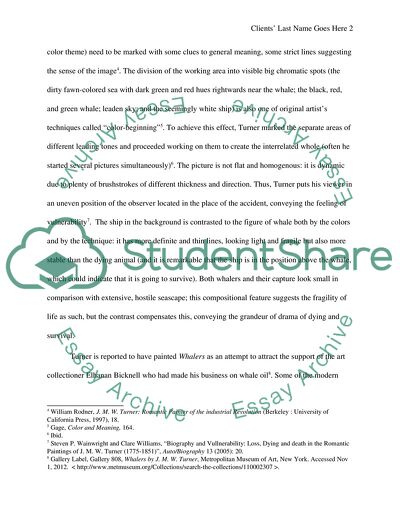
- Home
- Free Samples
- Premium Essays
- Editing Services
- Extra Tools
- Essay Writing Help
- About Us
- Studentshare
- Subjects
- Visual Arts & Film Studies
- The 19th Century Art History
The 19th Century Art History - Essay Example

- Subject: Visual Arts & Film Studies
- Type: Essay
- Level: Masters
- Pages: 7 (1750 words)
- Downloads: 0
- Author: emmittsenger
Extract of sample "The 19th Century Art History"
Turner is reported to have painted Whalers as an attempt to attract the support of the art collectioner Elhanan Bicknell who had made his business on whale oil8. Some of the modern critics label whaling as an “unpopular topic”9; however, there is evidence that whales were actually popular in the literary and visual art works of Turner’s contemporaries (some of the examples are J. Ross Browne’s Etchings of a Whaling Cruise and Francis Olmsted’s Incidents of a Whaling Voyage)10. There were several social and cultural factors that shaped the powerful image of whale in Romantic art: 1) whales belong to the sea, the setting that was perceived as wild and inferior to humans11; 2) nevertheless, the middle of 19th century happened to be the birth of studies in comparative biology, and there was a clear parallel between the bodily suffering of whales and that of humans12; 3) the figure of whale was connected with the dominance over sea resources, which was no less hot topic for Britain than for the US13.
Herman Melville (whose Moby Dick is actually the subject of Buell’s study cited here) saw Turner’s painting and could have been inspired by this bloody picture of the struggle for life (and for dominance also)14. Anyway, the conflict and the manner of its depiction are more or less typical for the Romantic painting, and some features of Turner’s technique allow for characterizing him as a Romantic painter. The sea and the sky occupy most of the picture’s space; they are the setting for battle between the whale (representing wild powers of nature) and whalers (who are attempting to tame these powers).
The picture is called Whalers, which means that the author is mainly concerned with human drama. They fight with both the sea and the whale, and the whale is also struggling for its life. In the times of technical revolution (the growth of steam power’s popularity), nature was seen as dangerous and unfriendly; technology with both fear and respect to its powers15. The threat invoked by spectacular views was connected with such category in Romantic aesthetics as ‘sublime’, the term used by German theorists and E.
Burke; the collision of two wild powers is a distinctly “sublime” theme16. Turner’s technique is also directed towards the depiction of this sublime mood: dynamic brush strokes, color contrasts, and the very size of the painting (36 1/8 x 48 1/4 in., or 91.8 x 122.6 cm) simultaneously scare and fascinate the viewer, directing attention from the event itself to the subjective interpretation of this event. More subjectivity is added by the fact that most areas of the painting are blurred; these are only rough sketches of the ship and the boats with whalers that suggest human presence here.
This way, mind and feelings of the viewers, in other words, their subjectivity, become actively engaged in this work. Turner’s marines communicate the sense of being lost in the sea, strengthening it with the dislocation of the source of light: suspense arises from “the sense of not knowing where the information – the power of vision – comes from”17. Turner had been through some of the sea accidents; he often admitted that those impressions were sources for his paintings. John Ruskin describes how harshly he reacted to the critics’ remarks about his Snowstorm (they claimed that the painting was “soapsuds and whitewash”): “I wish theyd been in it”18.
Marines and landscapes that immersed viewers with their unusual depiction of motion and vivid color interplay were typical for Turner. The work’s formal elements may also be seen in most of the paintings of his oeuvre. It was already mentioned that Turner’s strategy was to convey the feeling of scene rather than produce the mimetic depiction of the scene. This is a feature typically associated with Impressionism; however, unlike French symbolists, impressionists were not so favorable about Turner’s paintings.
They accused him of paying too little attention to the distribution of colors and too intensive work with the colors themselves19.
Read MoreCHECK THESE SAMPLES OF The 19th Century Art History
20th Century Literary Theory:Orientalism as a tool of colonial discourse
History of each instrument
Ukrainian Art and Culture: the Tartar Barbarism
The First Invention in Chemical Explosives
Middle Ages to the Enlightenment
The Tower of London
Calligraphy in Islamic Culture and Art
Art-History- Symbolism in 19th Century Art

- TERMS & CONDITIONS
- PRIVACY POLICY
- COOKIES POLICY